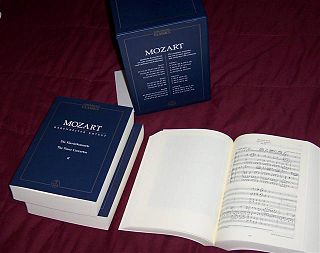
Wolfgang Amadeus Mozart, baptised as Johannes Chrysostomus Wolfgangus Theophilus Mozart, was a prolific and influential composer of the classical era.
The Adagio and Fugue in C minor, K. 546, is a composition by Wolfgang Amadeus Mozart for strings. Mozart entered it into his own work catalogue on 26 June 1788 in Vienna as "A short Adagio for two violins, viola and bass, for a fugue which I wrote some time ago for two Pianos". The fugue in question was the two piano fugue in C minor, K. 426, written in December 1783.
Joseph Leutgeb was an outstanding horn player of the classical era, a friend and musical inspiration for Wolfgang Amadeus Mozart.
The Nannerl Notenbuch, or Notenbuch für Nannerl is a book in which Leopold Mozart, from 1759 to about 1764, wrote pieces for his daughter, Maria Anna Mozart, to learn and play. His son Wolfgang also used the book, in which his earliest compositions were recorded. The book contains simple short keyboard pieces, suitable for beginners; there are many anonymous minuets, some works by Leopold, and a few works by other composers including Carl Philipp Emanuel Bach and the Austrian composer Georg Christoph Wagenseil. There are also some technical exercises, a table of intervals, and some modulating figured basses. The notebook originally contained 48 bound pages of music paper, but only 36 pages remain, with some of the missing 12 pages identified in other collections.

The Sonata in C major, K. 19d, is a work for piano four-hands once thought to be by composed by Wolfgang Amadeus Mozart in 1765 when he was nine years old in England. Composed in the traditional sonata form, it is one of the very few works thought to be written by Mozart for four-handed play.
The Symphony No. 4 in D major, K. 19, by Wolfgang Amadeus Mozart was composed in London during the Mozart family's Grand Tour of Europe in 1765, when Mozart was 9 years old.

The Sonata for Two Pianos in D major, K. 448, is a work composed by Wolfgang Amadeus Mozart in 1781, when he was 25. It is written in sonata-allegro form, with three movements. The sonata was composed for a performance he would give with fellow pianist Josepha Auernhammer. Mozart composed this in the galant style, with interlocking melodies and simultaneous cadences. This is one of his few compositions written for two pianos. This sonata was also used in the scientific study that tested the theory of the Mozart effect, suggesting that classical music increases brain activity more positively than other kinds of music.
The Serenade No. 6 for Orchestra in D major K. 239, Serenata notturna, was written by Wolfgang Amadeus Mozart in Salzburg, in 1776. Mozart's father, Leopold Mozart, wrote the title and a January 1776 date on the original manuscript.
Symphony No. 13 in F major, K. 112, by Wolfgang Amadeus Mozart, was written in Milan during the autumn of 1771. The symphony is in four movements, the second of which is scored for strings alone. The third movement minuet may have been written earlier, and then incorporated into the symphony—the autograph manuscript shows the minuet copied in Leopold's hand. Nicholas Kenyon describes Symphony No. 13 as the last in "conventional mode"—thereafter "we are in the beginnings of a different world."
Symphony No. 11 in D major, K. 84/73q, was at one time considered unquestionably to be the work of Wolfgang Amadeus Mozart. Its status has, however, been challenged, and remains uncertain. It is believed to date from 1770, and may have been written in Milan or Bologna, if it is a genuine Mozart work. An early manuscript from Vienna attributes the work to Wolfgang, but nineteenth-century copies of the score attribute it respectively to Leopold Mozart and to Carl Dittersdorf. Neal Zaslaw writes: "A comparison of the results of two stylistic analyses of the work's first movement with analyses of unquestionably genuine first movements of the period by the three composers suggests that Wolfgang is the most likely of the three to have been the composer of K73q".

The Mozart family grand tour was a journey through western Europe, undertaken by Leopold Mozart, his wife Anna Maria, and their musically gifted children Maria Anna (Nannerl) and Wolfgang Amadeus from 1763 to 1766. At the start of the tour the children were aged eleven and seven respectively. Their extraordinary skills had been demonstrated during a visit to Vienna in 1762, when they had played before the Empress Maria Theresa at the Imperial Court. Sensing the social and pecuniary opportunities that might accrue from a prolonged trip embracing the capitals and main cultural centres of Europe, Leopold obtained an extended leave of absence from his post as deputy Kapellmeister to the Prince-Archbishopric of Salzburg. Throughout the subsequent tour, the children's Wunderkind status was confirmed as their precocious performances consistently amazed and gratified their audiences.
Bona nox! bist a rechta Ox, K. 561, is a canon in A major for four voices a cappella by Wolfgang Amadeus Mozart; Mozart entered this work into his catalogue on 1788 as part of a set of ten canons.
The Symphony in G major "Old Lambach", K. Anh. 221/45a, was probably written by Wolfgang Amadeus Mozart during 1766 in The Hague and revised in 1767. Both versions – the original and the revision – have survived.
The Symphony in F major, K. Anh. 223/19a, was probably written by Wolfgang Amadeus Mozart in early 1765 in London.
The Symphony in A minor "Odense", K. Anh. 220/16a, was formerly attributed to Wolfgang Amadeus Mozart. It is one of only three symphonies possibly by Mozart to be in a minor key.
The Kyrie in F major, K. 33, is a sacred composition for choir and strings by a ten-year-old Wolfgang Amadeus Mozart, dated June 12, 1766. It was written while the composer was in Paris with his family, with the intent to promote his image as a child prodigy.
The lost Symphony in C major, K. Anh. 222/19b, was probably written by Wolfgang Amadeus Mozart in early 1765 in London. It is one of the twelve symphonies that Ludwig von Köchel only knew by its incipit in the Breitkopf & Härtel manuscript catalogue, which listed it as one of six symphonies (Nos. 65–70) sourced from Luigi Gatti (1740–1817), Court Kapellmeister in Salzburg from around 1782:
Sancta Maria, mater Dei, K. 273, is an act of Consecration to Blessed Virgin Mary in F major, written by Wolfgang Amadeus Mozart for SATB choir, first and second violins, violas and basso continuo of violoncello, double bass and organ. Mozart entered the work into his catalogue on 9 September 1777 in Salzburg.

The Adagio and Rondo, K. 617, is a quintet composed by Wolfgang Amadeus Mozart for glass harmonica, flute, oboe, viola and cello. Completed on May 23, 1791, it was written for Marianne Kirchgessner, a blind glass harmonica virtuoso, who played the first performance in the Burgtheater Akademie on June 10, 1791, and subsequently performed it at the Kärtnertortheater on August 19, 1791.











